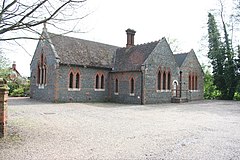Hoxne
village and civil parish in Suffolk, England, UK
Hoxne (pronounced 'Hoxen') is an ancient village in Suffolk, England, about five miles (8 km) east-southeast of Diss, Norfolk
| Hoxne | |
|---|---|
 Village Hall, Hoxne | |
| District | |
| Shire county | |
| Region | |
| Country | England |
| Sovereign state | United Kingdom |
| Post town | EYE |
| Postcode district | IP21 |

The area around the village is of great archaeological significance.
- It was one of the first places where flint hand axes were found (late 18th century).[1] John Frere [1740–1807], who lived at Roydon Hall in Diss, was the first person to recognise and write about the hand axes. He wrote a letter to the Society of Antiquaries. In this letter he connected the flints to strata in the site of an interglacial lake, part of the Hoxnian interglacial.
- It is the archaeological type site for the Hoxnian Stage or Hoxnian interglacial. The Hoxnian Stage is a middle Pleistocene stage of the geological history of the British Isles. It is equivalent to Marine Isotope Stage 11,[2][3][4][5] which started 424,000 years ago and ended 374,000 years ago.[6][7]
- It is the find-spot of the Hoxne Hoard of Roman treasure.
The village is also home to The Swan Inn. The Swan occupies a 15th Century, Grade II listed lodge, formerly known as Bishops Lodge. This pub is set at the bottom end of the village green, near Saint Edmund's memorial and bridge.[8] Built in 1480 by the Bishop of Norwich, The Swan has a long history; both the restaurant and bars reflect Hoxne's ecclesiastical past, with ornate ceiling beams and wide-planked floors.
References
change- ↑ Frere, John 1800. Account of flint weapons discovered at Hoxne in Suffolk. Archeologia, 13, 204-205
- ↑ Stringer, Chris (2006), Homo Britannicus: The incredible story of human life in Britain, London: Penguin, ISBN 978-0-14-101813-3.
- ↑ McMillan, A. A. (2005), "A provisional Quaternary and Neogene lithostratigraphic framework Great Britain", Netherland Journal of Geosciences, 84 (2): 87–107, doi:10.1017/S0016774600022988, S2CID 129552204.
- ↑ Walker, M. (2005), Quaternary Dating Methods, Chichester, United Kingdom: John Wiley & Son, ISBN 0-470-86927-5.
- ↑ Gibbard, P. L.; Boreham, S.; Cohen, K. M. & Moscariello, A. (2007), "Global chronostratigraphical correlation table for the last 2.7 million years v. 2007b (jpg version 844 KB )", Subcommission on Quaternary Stratigraphy, Cambridge, England: Department of Geography, University of Cambridge.
- ↑ Lisiecki L.E. 2005. Ages of MIS boundaries.LR04 Benthic Stack Boston University, Boston, MA
- ↑ Lisiecki, L.E. & Raymo, M.E. (2005), "A Pliocene-Pleistocene stack of 57 globally distributed benthic δ18O records" (PDF), Paleoceanography, 20 (1): PA1003, Bibcode:2005PalOc..20.1003L, doi:10.1029/2004PA001071, S2CID 12788441.
- ↑ refers to Saint Edmund the Martyr, born 869, King of East Anglia.